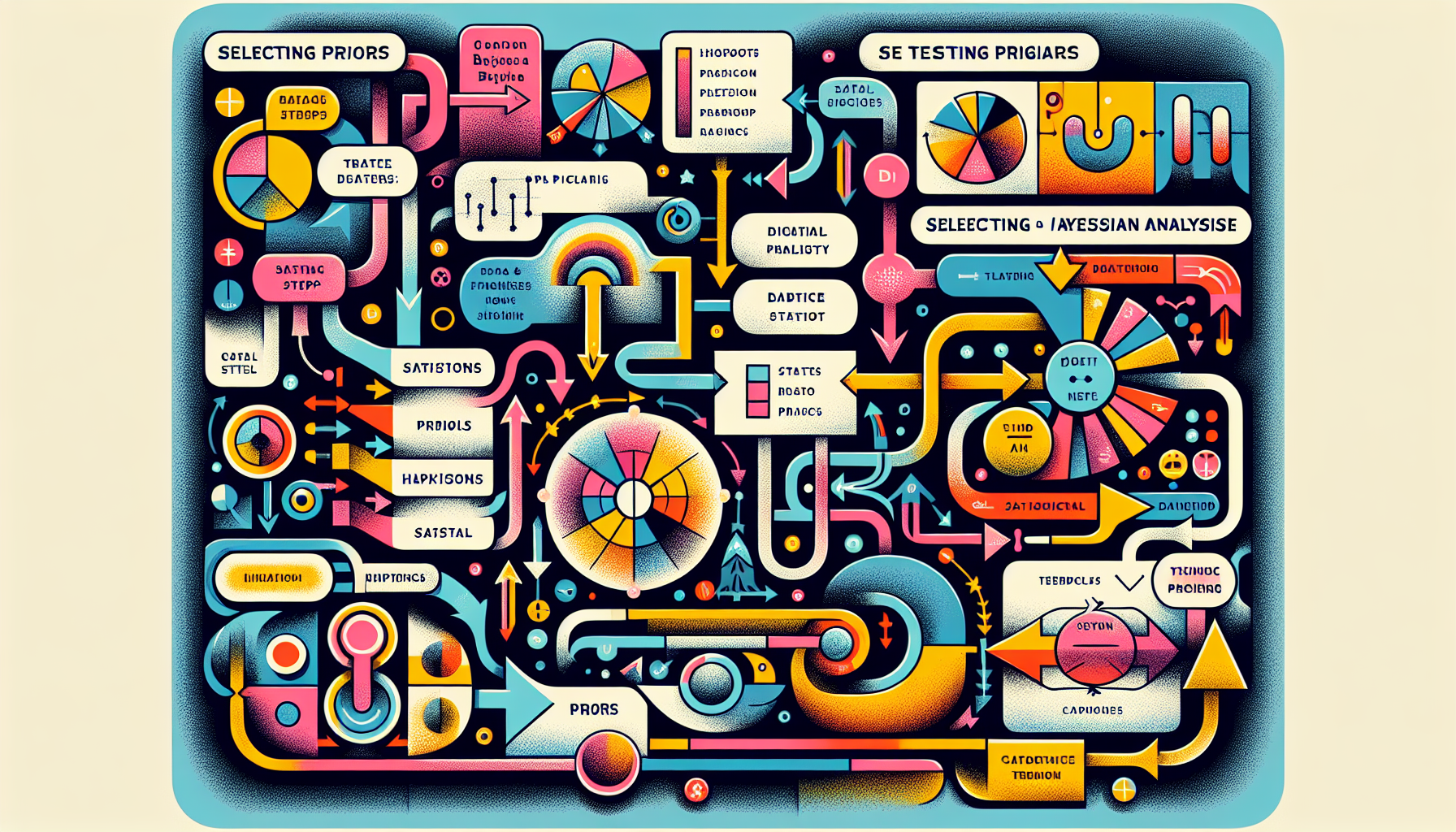Bayesian Machine Learning in Data Science

Bayesian Machine Learning in Data Science
Bayesian machine learning combines Bayesian statistics with machine learning to update predictions with new data, for more accuracy and better decisions. This post covers the basics, algorithms and real world use cases.
Summary
Bayesian machine learning combines prior knowledge and updates predictions with new data, for more adaptability and accuracy.
Algorithms like Maximum A Posteriori, Markov Chain Monte Carlo and Gaussian Processes make model building efficient and address the computational challenges of Bayesian inference.
Bayesian methods work in healthcare, finance and natural language processing, for robust solutions that account for uncertainty and better decision making.
Bayesian Machine Learning
 An illustration representing Bayesian machine learning concepts
An illustration representing Bayesian machine learning concepts
At the core of Bayesian machine learning is the idea of continuous updating of beliefs based on prior belief and on new evidence. Unlike traditional machine learning models that often have fixed parameters, these models have prior knowledge and refine predictions as more data comes in. This gives better accuracy and a measure of uncertainty which is critical for making decisions.
Bayesian inference is the key method in Bayesian machine learning. Updating the posterior probability of estimates of the hypotheses as new evidence comes in. This keeps our models relevant and accurate as new data points come in.
Combining Bayesian statistics with machine learning gives us statistical models that are strong and flexible.
Bayes’ Theorem
Bayes’ Theorem is the foundation of Bayesian inference, it’s a mathematical formula for updating the probability of a hypothesis based on new evidence. The formula is P(H|D) = (P(D|H) * P(H)) / P(D) where P(H|D) is the posterior, P(D|H) is the likelihood, P(H) is the prior and P(D) is the evidence. This allows us to combine our prior knowledge with the likelihood of new data to get the posterior, to update our beliefs as we get new information.
In practice Bayes’ Theorem refines predictions and makes decisions. For example in medical diagnosis it updates the the probability distribution of a disease based on prior knowledge of disease prevalence and patient symptoms.
Continuous updating of probabilities makes Bayesian methods strong.
Prior and Posterior
Priors are our beliefs about the parameters before we’ve seen any data, the starting point for Bayesian analysis. These can be informative, with a lot of prior knowledge, or non-informative, trying to have minimal impact on the posterior. Choosing the right priors is important, especially with limited data, as they matter a lot.
Posterior distributions are what we get when we update the priors with new data. This updated distribution reflects our new beliefs about the parameters, incorporating both parameter values from the prior and the new evidence. Being able to compute posterior probabilities is a big advantage of Bayesian methods, we can keep learning and adapting.
Bayesian Inference
Bayesian inference is the process of updating our probability estimates for a hypothesis as we get new evidence. This is different from frequentist statistics which often have fixed parameters and don’t update based on new data. By continuously refining our estimates Bayesian inference gives us a dynamic and adaptive way of making statistical inferences.
The process involves combining the likelihood of the observed data with the likelihood function the prior to get the posterior distribution. This keeps the models accurate and relevant even with new data.
Essentially, Bayesian inference enables more informed and precise predictions, enhancing model effectiveness.
Bayesian Machine Learning Algorithms
 An illustration showcasing key algorithms in Bayesian machine learning
An illustration showcasing key algorithms in Bayesian machine learning
Several algorithms in Bayesian machine learning help with model building and tackle the computational challenges of big data.
The most popular are Maximum A Posteriori (MAP), Markov Chain Monte Carlo (MCMC) and Gaussian Processes.
Maximum A Posteriori (MAP)
MAP estimation gives you a more map estimate and more accurate point estimate by maximising the posterior and incorporating prior knowledge so you get more precise and reliable predictions.
MAP is particularly useful when you can incorporate prior knowledge that will improve the model a lot.
Markov Chain Monte Carlo (MCMC)
MCMC methods are used for sampling from complex posterior distributions which are often intractable. Techniques like Gibbs and Slice Sampling allow you to sample from the posterior when analytical solutions are not possible.
By allowing you to sample from high dimensional spaces MCMC algorithms are key to Bayesian inference.
Gaussian Processes
Gaussian processes are a powerful way of modelling distributions over functions so are very useful in both regression and classification. They provide a flexible probabilistic approach to modelling uncertainty in predictions through their covariance structure. Gaussian processes can handle a wide range of applications from simple linear regression to more complex pattern recognition tasks.
In reality Gaussian processes can model the underlying patterns in the data and make predictions and identify patterns. Approximate solvers like Laplace Approximation are used to train these models so they work well even in complex cases.
Practical Applications of Bayesian Methods
 An illustration depicting practical applications of Bayesian methods
An illustration depicting practical applications of Bayesian methods
Bayesian methods have found applications across various fields, demonstrating their versatility and effectiveness. From healthcare to finance and natural language processing, Bayesian models offer robust solutions that account for uncertainty and continuously update predictions based on new evidence.
Healthcare
In healthcare, Bayesian models facilitate predictive analytics by integrating prior knowledge with clinical data to improve decision-making. For instance, Bayesian methods can enhance disease diagnosis by updating probabilities as new patient information becomes available, leading to more accurate and timely interventions. These models also provide a framework for analyzing treatment outcomes, assessing the effectiveness of interventions while accounting for uncertainties.
By estimating patient-specific risks and benefits from various treatment options, Bayesian models enable personalized care, ultimately improving patient outcomes and enhancing clinical decisions. Overall, the application of Bayesian methods in healthcare leads to better predictive analytics and more informed clinical practices.
Financial Markets
Bayesian techniques play a significant role in financial markets, supporting asset price forecasting and enhancing strategies for risk management. By adapting financial strategies based on newly available market data, Bayesian models help in optimizing investment portfolios and assessing risks more accurately.
This adaptability makes Bayesian estimation methods invaluable for informed financial decisions in dynamic markets.
Natural Language Processing
In Natural Language Processing (NLP), a Bayesian neural network is employed for tasks such as sentiment analysis and machine translation. These networks enhance performance by incorporating prior knowledge and continuously updating predictions as new training data is processed. The integration of Bayesian methods into NLP not only improves specific task outcomes but also contributes to more robust and interpretable models.
In sentiment analysis, Bayesian neural networks refine predictions based on new textual data, improving sentiment classification accuracy. Similarly, in machine translation, these networks improve the quality of translations by accounting for uncertainties and updating their parameters dynamically. This adaptability and robustness make Bayesian methods highly effective in NLP applications.
Selecting and Testing Priors
 An illustration of the process of selecting and testing priors in Bayesian analysis
An illustration of the process of selecting and testing priors in Bayesian analysis
Choosing the right priors is important in Bayesian analysis as it makes a big difference. This section covers types of priors and robustness testing to ensure you get good results.
Types of Priors
Informative priors use prior knowledge of predictive distribution to give you more accurate posterior estimates, non-informative priors try to have no influence on the posterior distribution. Conjugate priors which allow the posterior to be calculated in the same family of distributions as the prior make the computation easier and Bayesian analysis more tractable.
Robustness Testing
Robustness testing is checking how the results of Bayesian models change with different prior distributions to make sure you get good results. This helps you to see how sensitive the bayesian model is to different priors so your conclusions are robust.
Bayesian Inference Simplified
 An illustration simplifying Bayesian inference concepts
An illustration simplifying Bayesian inference concepts
To make Bayesian inference more efficient and easier to use several methods can be employed. This section looks at using conjugate priors and variational inference to simplify the inference.
Conjugate Priors
Conjugate priors simplify Bayesian calculations by keeping the same functional form for prior and posterior distributions, making it more tractable. In Gaussian processes conjugate priors allow for analytical computation of the posterior and prior distribution together, making inference more efficient.
Conjugate priors are useful when computational simplicity is key. Keeping the same family of distributions for the posterior calculations these priors reduce Bayesian inference complexity and make it more usable.
Variational Inference
Variational inference is a computationally efficient alternative to MCMC by turning the problem of approximating posterior distributions into an optimisation problem. This allows for faster approximations and Bayesian inference for big data and complex models.
Simplifies the calculation variational inference makes Bayesian more usable.
Computational Issues
Bayesian machine learning has big computational challenges especially with large data. This section will discuss how to make it more efficient and scalable.
Large Data Sets
Scaling Bayesian models requires methods that balance speed and accuracy and the trade-offs introduced by approximation methods. One way to do this is stochastic variational inference which approximates the posterior more efficiently so you can handle large data.
Parallel Computing
Parallel computing makes Bayesian computations faster by distributing the tasks across multiple processors. This reduces the time it takes to do complex inference and makes Bayesian methods more practical for real world applications.
By using distributed systems Bayesian machine learning can handle big data analysis better.
Conclusion
In summary Bayesian machine learning is a robust way to make predictions with uncertainty. By updating beliefs based on new evidence Bayesian methods make models more adaptable and effective across all fields. From healthcare to finance to natural language processing the practical applications of Bayesian methods show how powerful they are. As data scientists deal with complex data and computational issues Bayesian machine learning is a valuable tool to get reliable results.
FAQs
What is Bayesian machine learning?
Bayesian machine learning is a way of making predictions that combines the Bayesian approach to statistics with machine learning techniques and handles uncertainty in data well. It makes models more robust and interpretable.
What are prior and posterior distributions?
Priors are your initial beliefs about parameters and posteriors are those beliefs updated with new data.
How does MAP work?
MAP works by maximising the posterior, combining prior knowledge with data to give a more accurate point estimate prior probability. It allows you to make informed decisions based on what you already know and what’s new.
What is the role of MCMC in Bayesian inference?
MCMC is key in Bayesian inference as it allows you to sample from complex posteriors when analytical solutions aren’t possible.
How can Bayesian be used in healthcare?
Bayesian in healthcare improves predictive analytics and disease diagnosis and allows for personalised treatment by updating probabilities with new patient data. That means more accurate and bespoke healthcare.
- Summary
- Bayesian Machine Learning
- Bayesian Machine Learning Algorithms
- Practical Applications of Bayesian Methods
- Selecting and Testing Priors
- Bayesian Inference Simplified
- Computational Issues
- Conclusion
- FAQs
Content
Start Free, Scale Easily
Try the fully-managed vector database built for your GenAI applications.
Try Zilliz Cloud for Free